Day 6, Cho Lon: Vietnam's Chinatown & Thit Chó Dinner
- Rick

- Jan 9, 2019
- 9 min read
Updated: Sep 28
Previous:
We slept a little late into the morning but still got up around 8.30am for breakfast. We had no intention to miss the nice coffee at the guest house but skipped the baguettes as we had decided to try the beef noodle at Phở Quỳnh Restaurant in Phạm Ngũ Lão that was highly recommended by the staff at Nhat Thao Guest House.
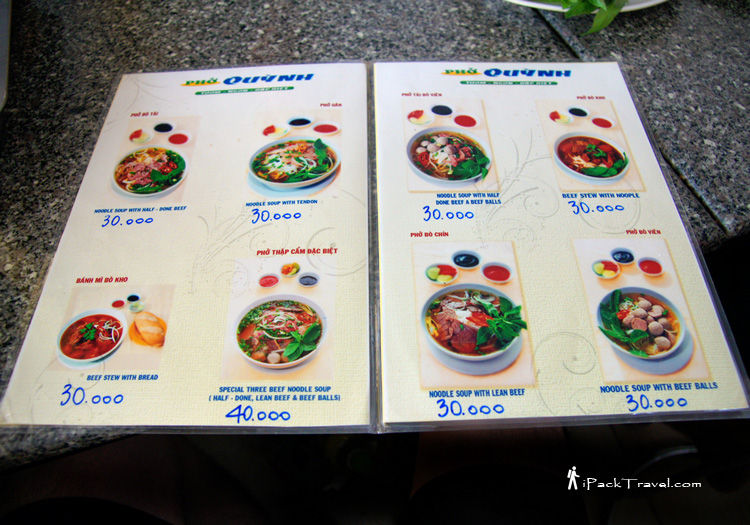
Phở Quỳnh was only 10 minutes' walk from Bui Vien Street. The 2-storey restaurant was located at a road junction and we requested to be seated on the second floor, away from the dust and smoke from the traffic. The restaurant's simple menu was colourful and the photos of the food looked appetising. We ordered our own liking and it turned out that most of us preferred the original phở bo (beef noodle). I ordered the Special Three Beef Noodle Soup, which had both half-done, lean beef meat and beef balls.
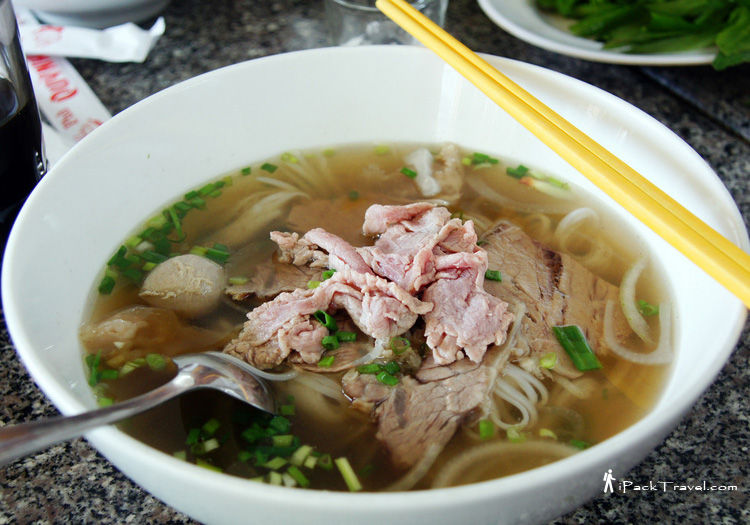
From the second floor, we could see the activities on the street below. I snapped a few photos of the street scenes while eating the beef noodle soup. Traffic in Ho Chi Minh City, or in most cities of Vietnam, used to be chaotic with no regards to traffic rules and regulations when I last traveled in the country 5 years ago. It was more orderly now. However, what was more attention-grabbing in the scenes below was the massive and ugly black wires that were strung from poles to poles, which were common sights throughout the city.
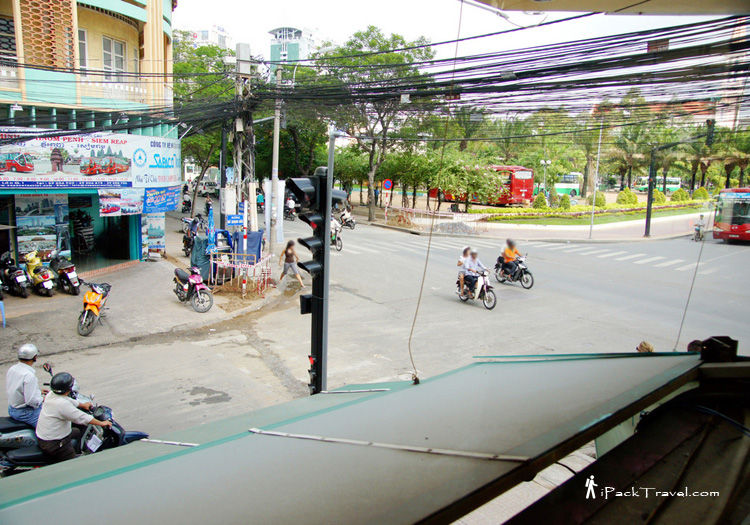
After breakfast, we walked to the bus station opposite Ben Thanh Market and took SaigonBus No. 1 to Cho Lon Bus Station (3.000 dong per person). We reached Cho Lon Bus Station at 11.30am and headed straight to Chợ Bình Tây (Binh Tay Market), skipping the fruit market besides the bus station for the time being. We would be back at the station again when heading back, so there was no need to buy fruits and carry them around.

Binh Tay Market was the largest indoor wholesale market in Ho Chi Minh City, well-known for its great bargains. Prices quoted on the goods here were much cheaper than Ben Thanh Market. However, Ben Thanh Market catered to tourists whereas Binh Tay Market catered more towards the locals. Unlike Ben Thanh Market, it was very crowded with goods in Binh Tay Market and the walking lanes between the stalls were narrower. The market was divided into sections, i.e. clothing in one section, kitchenware in another section, etc.
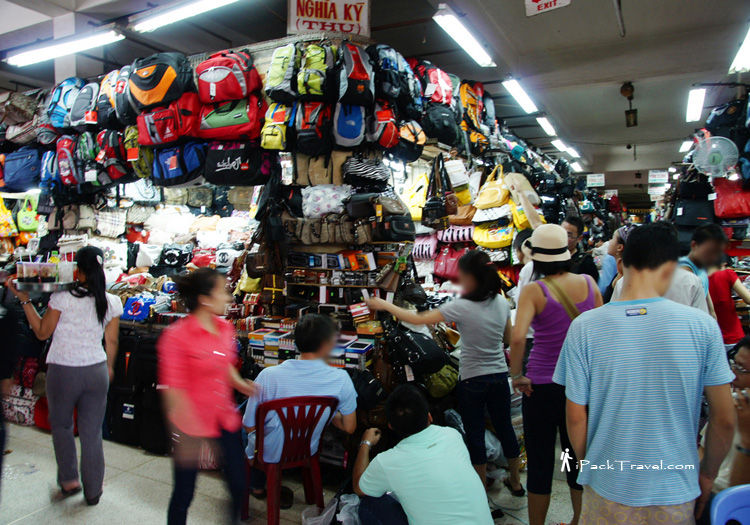
We spent more than an hour in Binh Tay Market, mainly for Shren and Joanne to bargain down the prices of two backpacks. Cheap as they might be, they were wary of quality issues though. But they bought them after some haggling.
After leaving the market, we strolled down Cho Lon, hoping to see more of the chinatown and also to look for a place to have lunch. We came across a stall selling herbal tea, stopped to buy some and Shren spoke with the young Vietnamese-Chinese owner in Cantonese. He told us that most of the older folks in Cho Lon spoke Cantonese but the younger ones spoke only Vietnamese.
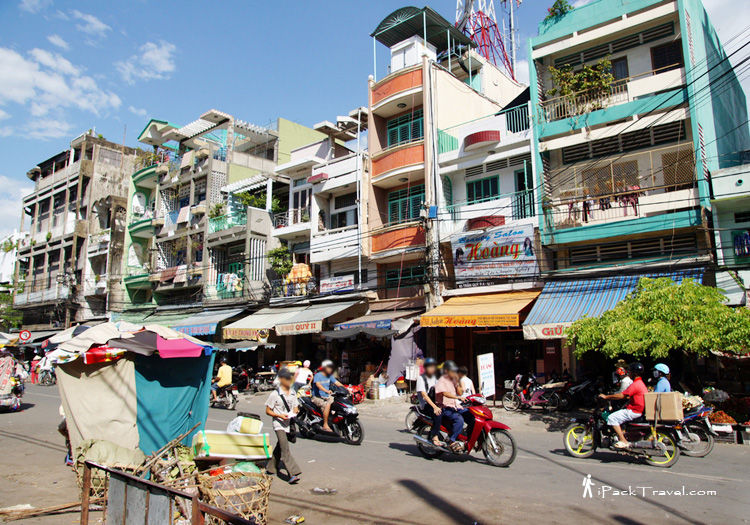
It was a mistake not to have lunch in the food section of Binh Tay Market. We walked for half an hour without seeing a food place until we saw a shop selling Chinese-style rice with pre-prepared dishes. We ordered some dishes and sat down at a table. Seeing that we were foreigners who spoke Mandarin, the owner of the shop welcomed us and played host by introducing some of the places in Cho Lon to us. He even offered to show us the way to a cheaper local market — on his motorcycle.

After lunch, we walked down several streets, pointed to the right directions by the friendly shop owner. While the others just walked and complained of the heat, I noted the landmarks along the way — in order to get back to the bus station later. The shop owner had promised to show us the way to the market but did not say he would wait for us. It would not be polite to make him wait either.
At the local market (did not note the name of this market), we thanked the shop owner and went in. Shren and Jeff went to scout for things to shop and the rest of us did a brief tour to check out the area. We came across a vendor selling durians, along an open-air food street behind the market, and bought a durian to try its taste. It was not the durian season, thus the smell and taste was not that fantastic. We shared the durian with Shren and Jeff after meeting up again in front of the market. None of them had bought anything.

I retraced the way we came and led the group back to the fruit market besides the bus station. It was already 3.30pm. Most of the stalls were still opened for business but the crowd had reduced greatly. We tasked ourselves to buy a type of fruit each to prepare for a fruit feast that night in the guest house. The others bought grapes, mangosteens, mangoes and a soursop. I could not find the fruit that I was looking for and decided not to get any. I was told that the star apple's season was over.

We took the same SaigonBus back to Phạm Ngũ Lão and headed back to our guest house to deposit all purchased stuffs in our rooms. We had a dinner appointment with Thanh, our eco-guide to the Mekong Delta, and Mai, the sale staff at the tour desk of Pao Cafe. We had agreed to meet at Pao Cafe and to introduce Thanh and Mai to one another. Although both of them worked for Innoviet, Mai was only about a week at the tour desk and Thanh just came back from another tour.
We went to Pao Cafe before the schedule time to have some drinks while waiting. Mai had went home for some reasons and could not join us for dinner. We ordered some fruit juices and Shren went out to a mobile vendor to buy a packet of fried carrot cake. The Vietnamese-style carrot cake was tasty and had more ingredients than expected. The simplicity and yet multi-flavourings of Vietnamese food were always full of amazing surprises.

Thanh arrived at 5.30pm after his working hours at Innoviet office on the outskirt of Phạm Ngũ Lão. He led the way and took us to the dining place, which was in an alleyway near to Phạm Ngũ Lão but known only to locals.
It was still early when we walked up to a two-storey cầy tơ (or thit chó) restaurant hidden in a side alley. Tables on the ground floor were mostly unoccupied. Thanh suggested that we occupied a table on the second floor to be less conspicuous, so we could enjoy the dinner without all the curious stares. After we were seated, Thanh did the ordering of the dishes since it would be difficult for us to communicate with the waitress. He also ordered bottled beers.
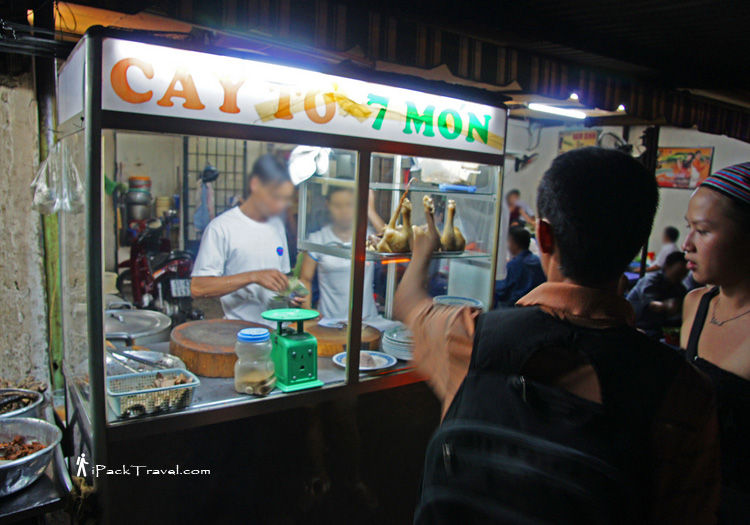
While waiting for the dishes to be served, Thanh explained to us the culture and belief of eating thit chó in Vietnam, especially in the north, where the meat was consumed towards the end of lunar months for good luck. Thanh said that it was also believed that the meat raise libido in men, thus some cầy tơ restaurants opened for business all year round. For me, I wanted to try the Vietnamese version since I had tried a number of times in China.

The three dishes were served almost at the same time. The first to arrive on the table was plain dog meat (thit chó) in thin slices including the skin. It came with a black sauce that had slices of onions and chillies on top. However, it smelled horrible! Like stench from a sewer. Thanh took a piece of the meat, dip it in the black sauce and ate it. We did likewise, braving the stench of the sauce and popping the meat into our mouths. It turned out that the taste was not that horrid and the skin was chewy.

The second dish was fried dog meat with sesame seeds. Like all fried food, the meat was slightly tougher but tasted nicer from the spicy sauce and sesame seeds. The smell of dog meat was also not that strong. It was naturally the most popular dish among our group. But I preferred the third dish.

Last on the table and bigger in portion than the first two dishes was a dog meat hotpot. Chunks of dog meat were cooked in soup with lots of bamboo shoots. The hotpot kept the meat constantly heated throughout the dining session. The real taste of dog meat was also better brought out in this dish than the other two — dog meat actually tastes like mutton. I preferred cooking-styles that maintained the natural tastes of meat.

Among our group, Shren was not ready to try the dishes due to her belief that dogs were human's best friends. Being impassive to such belief, I tried to get her to try a few pieces initially but surrendered when tears started to roll down her cheeks. Yet, she picked up a piece from each dish and tried them after she conquered her own fear. Human beings just liked to be governed by all sorts of conjured beliefs, I mused.
Frankly, the dog meat dishes that I tried this evening were not as tasty than the dog meat hotpot that I tried in China. But it did bring back memories of the good old taste.
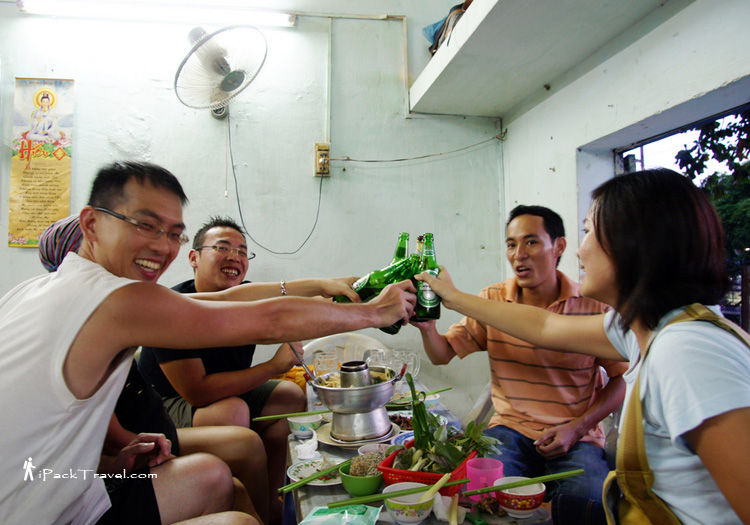
After we finished all the food and beers, we paid (only 310.000 dongs) and went down to the street. All the tables on the ground floor was crowded with local diners and they seemed surprised to see us, knowing that we were foreigners from the way we dressed, coming down the stairs. Well, it was the same kind of reactions when Singaporeans saw Caucasians eating durians in Singapore.
Thanh led the way again to a KTV nearby. It was a 15 minutes' walk with quite a number of turns and I, instinctively, noted a few landmarks at every turn. We reached the 4-storey Crown KTV and was shown to a room on the third floor. The room was so big that it could seat 12 persons comfortably.
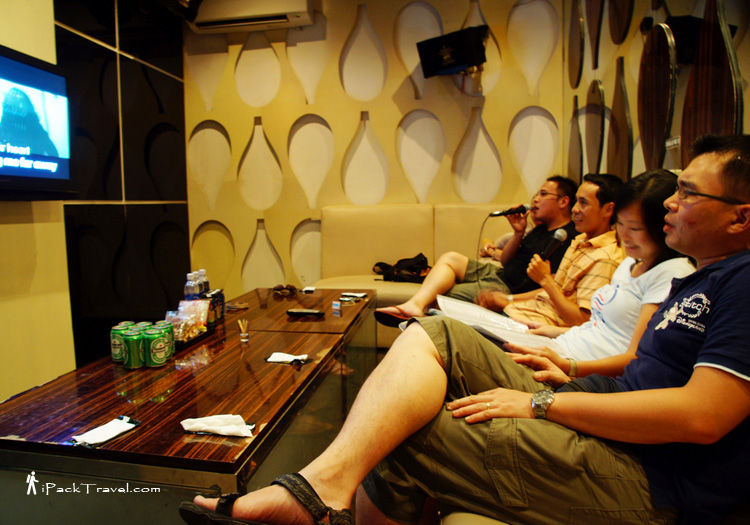
We ordered our drinks and sang a few songs that we could find in the limited song list that were not in Vietnamese. Thanh entertained us by singing some of the Vietnamese songs. He was a good singer. I could not sing well and entertained myself by listening to them. An hour later, Thanh had to leave as his girlfriend was waiting outside the KTV. We decided to leave too as we could not sing a lot and also worried that communication with the KTV staff might be an issue later.
We met Thanh's girlfriend outside, introduced ourselves and took a photo together. Thanh offered to show us the way back to our guest house but I told him I knew the way back. We bid goodbye to them and retraced our way back to Phạm Ngũ Lão.
We stopped at a supermarket along the way and went in to buy some local products that we could bring home. The supermarket closed at 10pm and we retreated with bags of coffee powder, instant noodles, vacuum-packed food, etc. It was Shren and Jeff's last night in Ho Chi Ming City.
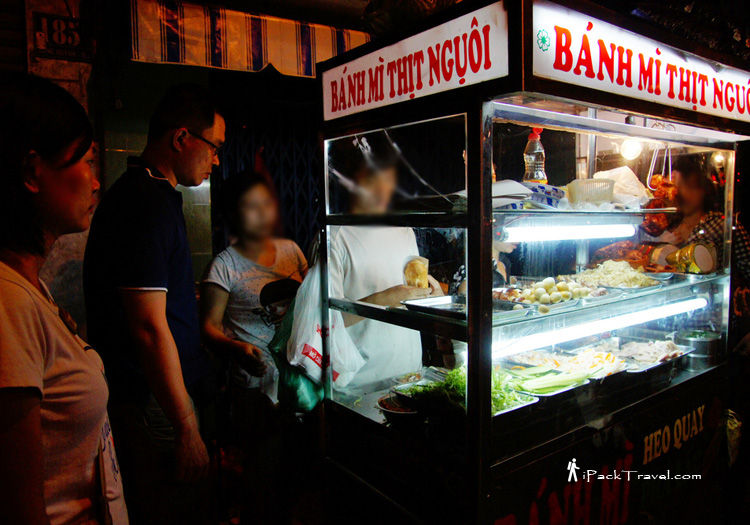
We also stopped by a couple of roadside stalls to buy supper — Shren was buying her dinner. One of the stalls sold bánh mì, a Vietnamese sandwich using baguette filled with several types of vegetables, such as cucumber, spinach, tomato, and mayonnaise and usually a meat filling. It was also a must-try food when in Vietnam. Each of us bought one.

Back along Bui Vien Street, we walked into Saigon T-Shirt Shop, which we had noticed earlier in the day. The t-shirts had interesting designs that were different from other shops. I bought two black t-shirts — one was named "iPhở" and broke down the phở bo into its four major components with "made in Vietnam" wordings below; the other was named "iTouch" and had four diagrams of hands on woman's naked body parts. It did not have the "made in Vietnam" wordings though. Cheeky.

(The idea of getting the "iTouch" t-shirt seemed to be fun and naughty, so I bought it. But it ended up in my wardrobe and unworn for the last 9 years! The tag is still on it.)
Back in Nhat Thao Guest House, we went to our rooms and brought out the fruits that we bought in the afternoon to the dining area. We ordered canned drinks from the guest house and ate the bánh mì and fruits. We even added some cheese that we bought at a supermarket into the sandwich. Simple food always tasted wonderful. But we could not finish the fruits and decided to save some for the following night.

After supper, we retired to our rooms. Shren and Jeff had to pack their luggage for their flight back to Singapore the next day. Joanne, Chavez and I had an extra day in Ho Chi Minh City.
Next:



Comments